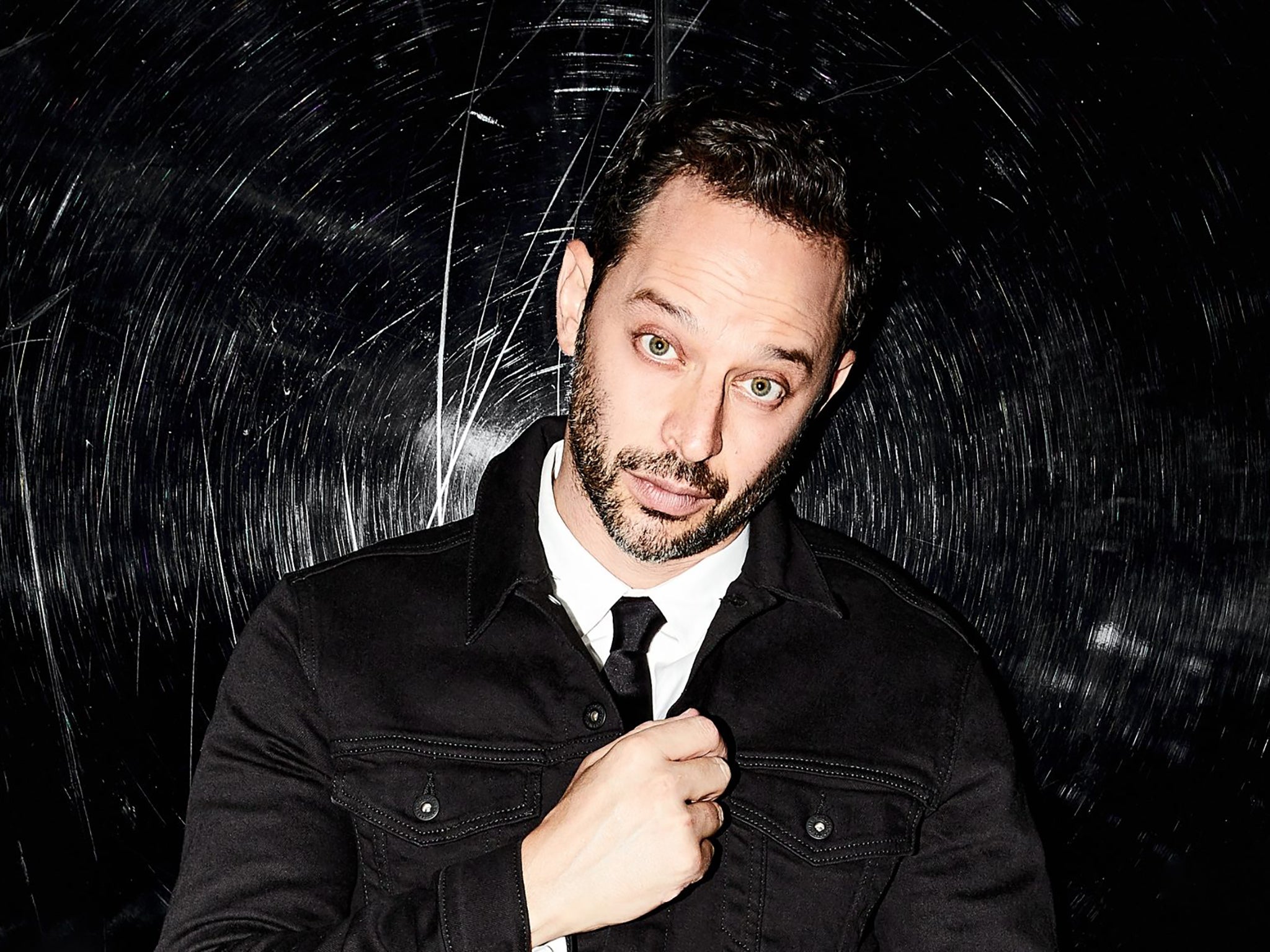Nick Kroll: ‘So much of Big Mouth is ripped off from Mel Brooks’
As his hit animated coming-of-age series returns, the American comedian talks to Kevin E G Perry about going from adolescent growing pains to working with his idol Mel Brooks


Your support helps us to tell the story
This election is still a dead heat, according to most polls. In a fight with such wafer-thin margins, we need reporters on the ground talking to the people Trump and Harris are courting. Your support allows us to keep sending journalists to the story.
The Independent is trusted by 27 million Americans from across the entire political spectrum every month. Unlike many other quality news outlets, we choose not to lock you out of our reporting and analysis with paywalls. But quality journalism must still be paid for.
Help us keep bring these critical stories to light. Your support makes all the difference.
If the success of Big Mouth has taught Nick Kroll anything, it’s just how many people in the world have had sex with their pillows. When he and his childhood best friend Andrew Goldberg were first dreaming up their hit animated show about the growing pains of puberty, they based the character of Jay Bilzerian, who has deeply involved relationships with a wide variety of soft furnishings, on a specific friend they knew as kids. Countless fans have let Kroll know since that their friend was far from unique.
“It happens a lot,” says the 43-year-old, a smile playing at the corner of his mouth as he speaks over a video call from his home office in Los Angeles. “It tends to be men who’ve had sex with pillows, but then there’s a lot of women who talk about corners of couches, or long baths with the faucet on. Very little surprises me now. That’s the beauty of the show. It makes you realise that the weird thing you did, or that you heard about, was happening all over the place. It’s all pretty common.”
Big Mouth returns for its fifth season this week, bringing us another instalment of what The New York Times has called “the greatest work of puberty-themed art ever created”. The initial premise of the show was for Kroll and Goldberg, along with co-creators Jennifer Flackett and Mark Levin, to explore the confusion of their own adolescence by following semi-autobiographical characters named Nick (voiced by Kroll) and Andrew (John Mulaney) as they lurch towards adulthood under the erratic influence of Andrew’s Hormone Monster Maury, a suitably deranged personification of puberty itself (also voiced by Kroll).
In the years since it debuted in 2017, the show has spread its fantastical wings and broadened its scope, telling stories that spread across a wide spectrum of adolescent experiences and ensuring that its female characters are shown to be just as vulgar and sexual as the boys. “We strive to have a very inclusive work environment and tell stories that are nuanced about all different groups of people’s experiences,” says Kroll. “Hopefully we’re telling stories that everyone involved in the show can be really psyched and proud of.”
As well as Hormone Monsters, the series has now introduced us to a whole range of emotional creatures from Depression Kitty to the Shame Wizard. Last season, the aggravating presence of Tito the Anxiety Mosquito entered the characters’ lives, a decision Kroll describes as “artistically gratifying” even if it doesn’t sound like it was all that fun to write. “You’re literally just talking about anxiety all day,” says Kroll with a wince. “It was weirdly challenging for us to live inside of that every day.”
The new season sees the introduction of lovebugs and hate worms, amorphous creatures that can shift between the two forms like caterpillars and butterflies. For Kroll and his writers’ room, these new characters presented an opportunity to explore a theme that felt both relevant for their characters and timely on a broader, societal level. “They’re at that age where you start to have kids falling in love with each other and having crushes,” points out Kroll. “As we kept talking about love and hate, we realised it felt very resonant to us all right now. Even if you’re not an adolescent kid with massive heartbreak, you can understand those feelings just because of where we are culturally.”
The new lovebugs and hate worms, along with many of the series’ other monsters, will reappear in forthcoming spin-off show Human Resources, described as a “workplace comedy set in the world of the monsters from Big Mouth”. While the series will allow Kroll and his team to explore a whole new range of human experiences, the good news for Big Mouth fans is that the two shows will continue to exist in tandem. The first season of Human Resources is set to arrive on Netflix next year, followed by the sixth season of Big Mouth and then the second season of Human Resources. “Things that are happening in the Big Mouth world with our monsters translate into the Human Resources world, and then there are storylines coming out of Human Resources and into Big Mouth,” explains Kroll, putting it in terms sure to delight and intrigue sitcom fans: “It’s as if Frasier and Cheers had been going simultaneously.”
Looking back now, Kroll says he doesn’t think his own puberty was especially bad, but it did arrive late. He grew up in Rye, a small suburban city in Westchester County, New York, as the youngest of four siblings. His family, much like the fictional Nick’s on Big Mouth, were close and generally supportive. His parents gave him a copy of Peter Mayle’s children’s guide to puberty, What’s Happening To Me?, and he recalls studying the illustrations of the changing male body. “I remember that very clearly,” he says. “I was always trying to see where I fit in the trajectory, you know?”
When he started high school, aged 14, Kroll was barely five foot tall. By the time he was 17 he’d shot up another 10 inches, but that still left several years in between where he felt like he was somehow falling behind. “I was suffering from ‘compare and despair’,” he says. “I was looking at my friends who had facial hair, or had underarm hair, or got bigger and could play sports at a level that I couldn’t. All of a sudden there was this major divide. I would have been scared for a girl to see my penis at a certain age, because I hadn’t hit puberty.”

Watch Apple TV+ free for 7 days
New subscribers only. £8.99/mo. after free trial. Plan auto-renews until cancelled

Watch Apple TV+ free for 7 days
New subscribers only. £8.99/mo. after free trial. Plan auto-renews until cancelled
It was only when he looked back on the period as an adult that Kroll realised his best friend had been going through hell in a different way. “Andrew, like so many other early bloomers, had to deal with the other side of it,” he says. “Things like terrible acne, and their voice cracking, and having no control over their hormones, or having boners in class. What I’ve found through making this show is that whatever version of puberty you had, it was hard. It’s a very weird, confusing and largely lonely time.”

That sort of loneliness and confusion can make a young man turn to comedy. As a teenager, Kroll would watch movies like Mel Brooks’s 1981 classic History of the World, Part I, which his family owned on VHS, over and over until he knew it by heart. Brooks, the comic genius behind The Producers, Young Frankenstein and Blazing Saddles, is a huge part of Kroll’s comedic DNA, so it was very much a dream come true when he received a call from his hero last year asking him if he’d like to be a part of making History of the World, Part II. It was recently announced that the long awaited and much anticipated follow-up will be coming to Hulu as an eight-part series, with Brooks saying in a statement: “I can’t wait to once more tell the real truth about all the phony baloney stories the world has been conned into believing are History!”
As well as producing and writing the new series, Kroll will also be appearing in it alongside fellow writer-producers Ike Barinholtz and Wanda Sykes, plus a few surprise guests. “We’ll be bringing in friends and great people to play characters throughout,” he says. “We’re still working it out. We’ve literally just assembled the writers’ room. We’ve got a great group of writers and Mel is popping by the room in the afternoon so we can pitch him ideas. It’s truly, truly surreal. There are so many things that I’ve ripped off directly or through osmosis from Mel Brooks. The way he breaks the fourth wall, the way he does genre parody, so much of that comes up in Big Mouth, and in everything I do.”

While we won’t go into detail here, the concluding episode of the new season of Big Mouth features an ambitious, Brooksian storytelling twist as Nick sets out in search of whoever’s supposed to be in charge of the cavalcade of monsters playing havoc with his psyche. While it may have started out, as Maury puts it, as a show about “middle-aged people playing masturbating children, with big feelings!”, Big Mouth has blossomed into an astute and open-hearted examination of what it means to be human.
“There’s a large conversation that we’ve been having about: ‘How does all of this work?’ ‘Who’s running the show?’” says Kroll, who believes he’s approaching an answer. “My general philosophy in life is that you have to figure out how to not let any of your monsters be in charge. You don’t want your Lovebug, your Hormone Monster, your Depression Kitty or your Shame Wizard to be running things too heavily. At least that’s the goal for me. All of those creatures have a seat at the table, but ultimately the way I’ve tended to live my life has always been about trying to find that balance.”
Season five of ‘Big Mouth’ is on Netflix from 5 November



Join our commenting forum
Join thought-provoking conversations, follow other Independent readers and see their replies
Comments